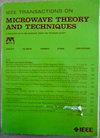Joint Communication and Sensing at D-Band SDR and at 5.8 GHz via Multibeam Arrays
IF 4.1
1区 工程技术
Q2 ENGINEERING, ELECTRICAL & ELECTRONIC
IEEE Transactions on Microwave Theory and Techniques
Pub Date : 2025-03-15
DOI:10.1109/TMTT.2025.3566499
引用次数: 0
Abstract
Joint communication and sensing (JCAS) are gaining attention as essential solutions to address the requirements of modern applications while promoting the efficient utilization of spectrum resources. Further, GPS-denied location, navigation, command, and control for unmanned aerial systems (UAS) is important from the standpoint of modern military applications, where GPS is usually not available. In this article, we discuss JCAS using 5.8 GHz industrial, scientific, and medical (ISM) band data communications using a software-defined radio (SDR) approach, where range and direction information is recovered through real-time cross correlation methods across multiple simultaneous receive beams in a single shot. Further, a multifrequency active repeater technique is proposed, where the uplink is at the D-band, and the downlink occurs at 5.8 GHz ISM band, which allows secure and safe command and control of a UAS while allowing location and enhanced security using JCAS in a GPS denied environment. Preliminary experiments using SDR with D-band wireless transmissions for connectivity to a UAS (uplink) ensure that the ground station uses directional transmissions from ground-to-air, making it difficult to detect from ground-based sensors. Further, an active down-converting repeater at the UAS allows omni-directional downlink transmissions at the UAS, making the location of the ISM and array receiver (ground station) difficult to detect from ground-based sensors using direction finding methods. Experimental testbed allows 100 Mbps data rate (up/down) at 147 GHz and 5.8 GHz ISM band, multiple snapshot-based averaging for improved SNR, and 32-beam multibeam digital array receivers for directional and range information over 180° in a single shot. All implementations are real-time and operate on FPGA technology. Ground station uses approximate discrete Fourier transform (DFT)-based beamformers having linear arithmetic complexity for achieving realtime DSP at low arithmetic complexity.基于多波束阵列的d波段SDR和5.8 GHz联合通信与传感
联合通信与传感(JCAS)作为满足现代应用需求、促进频谱资源高效利用的重要解决方案,正受到越来越多的关注。此外,从现代军事应用的角度来看,GPS拒绝定位、导航、指挥和控制无人机系统(UAS)是重要的,因为GPS通常是不可用的。在本文中,我们讨论了使用软件定义无线电(SDR)方法的5.8 GHz工业、科学和医疗(ISM)频段数据通信的JCAS,其中通过在单次射击中跨多个同时接收波束的实时相互关联方法恢复距离和方向信息。此外,提出了一种多频有源中继器技术,其中上行链路位于d频段,下行链路位于5.8 GHz ISM频段,该技术允许在GPS拒绝环境中使用JCAS进行定位和增强安全性的同时,安全可靠地指挥和控制无人机。初步实验使用SDR与d波段无线传输连接到UAS(上行链路),确保地面站使用地对空定向传输,使地面传感器难以检测到。此外,UAS上的主动下转换中继器允许UAS上的全向下行传输,使得ISM和阵列接收器(地面站)的位置难以使用测向方法从地面传感器检测到。实验测试平台可在147 GHz和5.8 GHz ISM频段实现100 Mbps的数据速率(上/下),基于多个快照的平均可提高信噪比,32波束多波束数字阵列接收器可在单次发射中获得180°以上的方向和距离信息。所有的实现都是实时的,并在FPGA技术上运行。地面站采用近似离散傅立叶变换(DFT)波束形成器,具有线性算法复杂度,实现低算法复杂度的实时DSP。
本文章由计算机程序翻译,如有差异,请以英文原文为准。
求助全文
约1分钟内获得全文
求助全文
来源期刊

IEEE Transactions on Microwave Theory and Techniques
工程技术-工程:电子与电气
CiteScore
8.60
自引率
18.60%
发文量
486
审稿时长
6 months
期刊介绍:
The IEEE Transactions on Microwave Theory and Techniques focuses on that part of engineering and theory associated with microwave/millimeter-wave components, devices, circuits, and systems involving the generation, modulation, demodulation, control, transmission, and detection of microwave signals. This includes scientific, technical, and industrial, activities. Microwave theory and techniques relates to electromagnetic waves usually in the frequency region between a few MHz and a THz; other spectral regions and wave types are included within the scope of the Society whenever basic microwave theory and techniques can yield useful results. Generally, this occurs in the theory of wave propagation in structures with dimensions comparable to a wavelength, and in the related techniques for analysis and design.
 求助内容:
求助内容: 应助结果提醒方式:
应助结果提醒方式:


